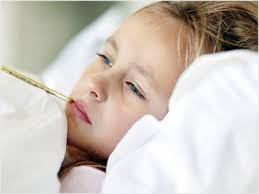
Fever phobia is alive and well. Nothing sends a family to the ER at 2 in the morning like a high fever. So what is a fever and when do parents need to worry? Keep in mind that a fever is defined by a body temperature over 100.4 Fahrenheit, regardless of your child’s normal resting temperature. Also, your body normally gets warmer in the evening so it is very typical to see fevers occur at night more than during the day.
What causes a fever?
Think of your brain as a thermostat. When your immune system is faced with an invader (most commonly a virus in children) one of it’s responses is to turn up the thermostat. This higher body temperature helps kill the germs. So in reality, a fever is good for you! Now, in order to generate heat and increase the body temperature, the muscles will shake. This is known as “chills”. After the body is finished with the fever, the blood vessels all dilate and you sweat out the extra heat.
Is a fever dangerous?
As stated above, fevers are good because they help kill the viruses and bacteria that infect us. A high temperature due to a fever is not the same as hyperthermia or heat stroke. The brain will not allow the body to get to a dangerous temperature. Adding heat by wrapping your child in blankets can cause the body temperature to get too hot, so try to avoid adding extra heat. However, children can sometimes experience dehydration during a fever because of increased metabolic demands when the body temperature reaches 102.5 or higher. Therefore, parents can give fever reducing medications like Tylenol or Ibuprofen and should be sure their child is getting plenty of fluids. For dosing information, please contact your doctor.
What is a febrile seizure?
A febrile seizure typically occurs in children 6 months to 6 years of age and can happen during a rapid change in body temperature. The seizure itself is usually less than 5 minutes and does not cause brain damage. It will typically alarm parents, sending them to the emergency room, but no anti-seizure medication will be necessary. The important thing to remember is to AVOID drastically lowering your child’s temperature in a cool bath. Once they come out of the cool water, if the brain still wants the body to be hotter, the temp will shoot up and that is when you can see a seizure.
When should I take my child to the doctor?
If your child is less than 3 months old, they should be seen immediately if they have a fever. Fever in this age group can be a sign of a serious bacterial infection and tests may need to be done to make the diagnosis. For all other children, it is important to look at their symptoms and consider what is causing the fever. Do they have a cold? Is there vomiting and diarrhea? For otherwise healthy children with straightforward viral symptoms, they do not need to be seen right away for a fever. If there are concerning symptoms like trouble breathing, ear pain, severe abdominal pain or sore throat (to name a few), take your child in. Any fever over 5 days or any fever without an obvious explanation should be evaluated. The good news is that serious bacterial infections that used to cause fevers without an obvious source are now prevented by vaccines. The best thing you can do for your child to prevent serious illness is to keep their vaccines up to date.
As always, when in doubt, call your child’s doctor with any questions or concerns.
To read more blog posts by Dr. Jaime Friedman, go to www.drjaimewfriedman.com.








Leave a Reply